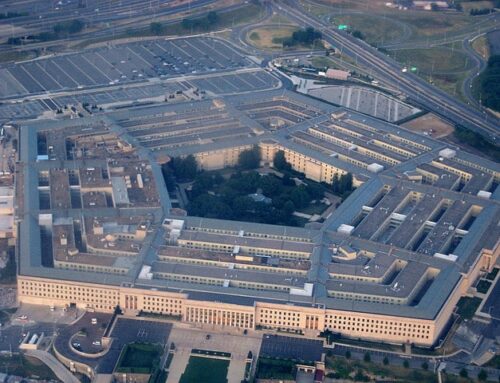At the September 10 presidential debate, Vice President Kamala Harris described her support for maintaining the “most lethal fighting force” in the world. Almost certainly that includes the United States’ plan to upgrade its nuclear arsenal with more powerful, more accurate nuclear warhead delivery systems, as well as new tactical nuclear warheads and bombs for use on the battlefield.
The world is already awash in nuclear weapons with an astonishing capacity for mass death: The U.S. has 14 Ohio-class nuclear-armed submarines. A single submarine can launch 24 missiles. Each missile can carry eight independently targeted warheads with blast forces many times greater than the Hiroshima bomb — 100,000 tons of TNT equivalent versus 15,000 tons. The missiles launched from just one such submarine can obliterate the major cities of any nation on Earth. The U.S. also maintains 400 intercontinental ballistic missiles (ICBMs) in fixed silos and hundreds of strategic nuclear bombs mounted on B-52 and B-2 bombers.
The U.S., North Korea, France, Russia and China are all upgrading their nuclear weapons arsenals, developing new nuclear weapons, or deploying them more closely to current target areas. Israeli leaders have threatened to use nuclear weapons against Iran, a risk which has intensified since the former’s escalation against Lebanon. Russia has threatened to use nukes if Ukraine moved to join the North Atlantic Treaty Organization, or if the U.S. assists Ukraine in firing conventional missiles deep into Russia. The U.S. has never disavowed first use of nuclear weapons in a conflict. Russian scholar Gilbert Doctorow worries that the U.S. may launch a first nuclear strike against Russia to prevent its total victory in Ukraine. Former senior CIA analyst Ray McGovern, one of several members of Veteran Intelligence Professionals for Sanity, fears the U.S. may use tactical nukes in Ukraine to forestall total Russian victory in that war. Trump’s advisers are calling for renewing nuclear weapons testing, in violation of the multilateral Comprehensive Nuclear-Test-Ban Treaty.
The first steps in this unsound direction were taken by the U.S. under President Barack Obama, when design and production of this new generation of nukes began. Presidents Donald Trump and Joe Biden continued with Obama’s plan, increasing its annual funding.
The 2023, U.S. military budget voted by Congress, included $51.5 billion for nuclear weapons, an 18 percent increase over the previous year and more than all of the other nuclear-armed nations combined. The budget continues funds for upgrading all three legs of the U.S. nuclear weapons triad — ICBMs in fixed silos, nuclear-armed submarines and long-range strategic bombers — with new nuclear missiles. This is happening as the U.S. — the world’s most powerful nuclear-armed nation — has withdrawn from major nuclear disarmament treaties representing decades of successful diplomacy.
In addition, since the U.S. withdrew in 2019 from the Intermediate-Range Nuclear Forces Treaty, the U.S., Russia and China have resurrected and deployed tactical nuclear weapons. The U.S. has B61-12 warheads deployed on Trident submarines, U.S. bomber forces and air bases in several western European countries. The warhead has several dialable blast forces that range from one-forty-third to three and a third times the force of the Hiroshima blast.
The most unsound, dangerous and destabilizing component of this plan is the replacement of 400 Minuteman III fixed-silo ICBMS with new Sentinel ICBMs in rehabilitated and expanded siloes. Six hundred and fifty-nine Sentinel missiles will be produced, and 450 missile silos and 600 facilities will be refurbished and upgraded. The Sentinel has a range of 6,000 miles. In a 2020 Union of Concerned Scientists report, David Wright, William Hartung and Lisbeth Gronlund detailed the limitations of the ICBM force, including human and technical errors leading to mistaken launch and their fixed-position vulnerability. Military firms profiting from the Sentinel, such as Northrop Grumman, “have donated $87 million to members of Congress in the last four election cycles alone,” according to Hartung in a separate August 2024 report. Recently, more than 700 U.S. scientists called for canceling the Sentinel replacement of Minuteman ICBMs.
Because the silo sites are fixed and well known, they are sitting ducks for attack. Nuclear-armed nations assume that precision-guidance attacks on the silo-based missiles would be successful. This leads to the “use or lose them” policy, resulting in the missiles being kept on high alert. With 400 missiles on hair-trigger alert, sooner or later there is the catastrophic possibility of an inadvertent or accidental firing. With active monitoring of such launches by Russia and China, their militaries could easily misinterpret any firing as an attempted U.S. first strike. This could trigger a massive counterattack, and even the onset of a devastating nuclear war.
A nuclear U.S.-Russia exchange of just land-based ICBMs would kill hundreds of thousands in the U.S. within a few days in the five western states where the silos and related facilities are located: Colorado, Wyoming, Montana, North Dakota and Nebraska. Prevailing winds would kill hundreds of thousands more in adjacent states to the east, and eventually radiation would kill a total of around 20 million all the way to the Atlantic coast. U.S. farmland would be useless for generations.
The “ICBM lobby” claims that replacing all our silo-based ICBMs in Wyoming, North Dakota, Arkansas and Montana with new Sentinel ICBMs will increase national security. Yet in 2016, former Defense Secretary William Perry wrote in The New York Times, “that the United States can safely phase out” its land-based ICBM force. He argued that the ICBM force is too costly and dangerous, while submarine and bomber forces are highly accurate and thus are “sufficient to deter our enemies and will be for the foreseeable future.” Various analysts have pointed out that the fixed and known location of silo-based ICBMs renders them far more vulnerable than mobile subs and bombers.
Americans need to understand that many of their unmet needs represent the draining of public tax dollars into weapons budgets.
The nuclear warfighting doctrines of both the U.S. and Russia demonstrate that the land-based ICBMs offer no security — only greater risk of Armageddon. It has been acknowledged for decades by the nuclear establishments of both the U.S. and Russia that accidental nuclear war is most likely to occur from mistaken indication that one side has launched their ICBMs. If that is believed, the other side has only a few minutes to decide whether to launch their own. So, if any Sentinel was launched, all 450 U.S. silos and related national ground, air and space communications, and command and control centers would be counterattacked. Each nation’s land-based ICBMs targets the others, while sub, ship and bomber nukes target other military and conventional targets.
Sentinel Costs and Contractors
In 2020, Northrop Grumman was awarded a sole-source $13.3 billion contract for engineering and manufacturing Sentinel missiles to replace the current arsenal of 500 Minuteman III ICBMs, and the Department of Energy began spending around $1 billion a year making the new W87-1 warhead. That year, the Pentagon estimated that the total cost of the next-generation Sentinel program, including decades of operations and support, could be as high as $264 billion.
The U.S. Air Force notified Congress in January 2024 that the new Sentinel intercontinental ballistic missile would cost 37 percent more than expected, triggering a congressional review, and take about two years longer than planned to build and deploy. Subsequently, in June, the cost jumped again to 81 percent over the original accepted production cost.
The cost per unit for the Sentinel system originally was projected to be $118 million and now is estimated at $162 million, putting the projected total production cost at roughly $141 billion over the next decade, up from an estimated $96 billion. We estimate that the warhead cost over 10 production years will rise from $1 billion a year to an average of $2 billion a year over the 10 years, for a total of $20 billion. Adding $20 billion for the warhead to $141 billion for the missiles, silos and facilities gives us a total production cost of $161 billion. So, during the decade of production, cost will be $16 billion a year. Much of the rising costs are due to the vast real estate development taking place over 40,000 square miles of land: new utility lines, support buildings, deeply buried communications, and refurbished and expanded silos. Most of the work will be at Malmstrom in Montana, Minot in North Dakota, and Warren in Wyoming. As history and current events tell us, current cost estimates will rise. Our current estimate for 50 years of operation and maintenance starting in 2030 is $200 billion. Added to the $161 billion production cost, we estimate total lifetime program cost to be around $360 billion. The expected delay of the system’s initial operating capability will result in additional billions in life-extension costs to keep the existing fleet of Minuteman III ICBMs operational through Sentinel deployment completion late in the 2030s.
It’s helpful in assessing the financial clout of the ICBM lobby to review some of the contracts. Prime contractor Northrop Grumman’s development contract is spreading the wealth among these principial subcontractors:
- Lockheed Martin will provide the reentry vehicle that deploys the warheads to their targets.
- Textron will supply key reentry systems in work with Lockheed.
- Clark Construction handles infrastructure program management.
- Bechtel works with Clark designing and refurbishing 450 launch silos, 600 facilities and buried communications in five states.
- L3harris subsidiary Aerojet Rocketdyne is building the three-stage solid-fuel rockets and propulsion systems.
- General Dynamics supplies the command and control systems and vehicles to transport missiles.
- RTX subsidiary Collins Aerospace is producing airplanes with airborne systems to conduct ICBM warfare from the air, and is providing training for command and control systems.
- CAE provides training systems for the Sentinel project.
- Honeywell is responsible for guidance and control instruments, and booster control.
The warhead is the first new U.S. strategic warhead in decades. Nuclear warheads are produced by the Department of Energy. The Sentinel’s W87-1 will be designed by Lawrence Livermore and Sandia National Laboratories, and produced by Los Alamos National Laboratory, Savannah River Site, Kansas City National Security Campus, Y-12 National Security Complex, Pantex Plant and key conventional explosives supplier Holston Army Ammunition Plant. The design is based on the W78, which has a blast force equivalent to 335 to 350 kilotons of conventional TNT explosive. That’s a bomb from 22 to 23 times more powerful than the Hiroshima bomb. It is upgradable to nearly 32 times Hiroshima. We have not been told what the yield of the new W87-1 will be, but as a counterforce weapon designed to take out hardened missile silos, we are guessing it will have a blast force around 100,000 tons of TNT equivalent (six-point-seven times Hiroshima’s 15,000 tons).
Mistaken ICBM Launch Poses Existential Threat
Since fixed silos are vulnerable, their destruction would be guaranteed if an attack was detected. In many scenarios, the U.S. may only detect a Russian counterforce attack 20-25 minutes before the U.S. missiles would be destroyed, so there’s little time to determine the validity of the incoming attack.
Nuclear warfighting history is replete with a half-dozen instances when either the U.S. or Russia confirmed an incoming counterforce attack. The Union of Concerned Scientists maintains a list of such close calls. In each case, someone was able to stop the retaliatory ICBM launch, and in each case, it was later determined that there had been no attack at all.
As former Secretary of Defense Perry says, in case of a false detection of an attack, any president would be under pressure to launch only the Sentinels, to “use them or lose them” before the attacking warheads arrive. Perry thinks the greatest existential threat to the planet at this time in history is precisely such a mistaken launch. In 1979, he personally called off a retaliatory counterforce launch of most U.S. strategic missiles when informed at 3 am that all detection systems confirmed a massive Russian counterforce attack would strike the U.S. in 20 minutes. Perry didn’t believe it, because of relatively calm U.S.-Russia relations at the time, and refused to retaliate. Within hours it was discovered that a nuclear warfighting training tape had accidentally been inserted and had taken over.
Some experts, such as Perry and Gabe Murphy, a national security policy analyst with Taxpayers for Common Sense, say that the U.S. should get rid of ICBMs entirely. “Whatever strategic value nuclear ICBMs may have held in the past, in our current security environment, they serve as little more than a bottomless pit … [into] which the Pentagon throws taxpayers’ hard-earned money,” Murphy wrote in Stars and Stripes.
The Arms Control Association, an organization of nuclear weapons scientists, administrators and nuclear warfighting academics and analysts, says the Sentinel is not necessary, destabilizing and too dangerous regarding the possibility of a mistaken launch under the minutes of “use them or lose them” pressure.
Sentinel’s Opportunity Cost
The Congressional Budget Office 2023 report projected overall nuclear weapons expenditures of $756 billion from 2023-2032. These hundreds of billions represent taxpayer dollars that will not be available to fund critical human needs programs for housing, education, transportation, biomedical research, climate mitigation or environmental protection. Americans need to understand that many of their unmet needs represent the draining of public tax dollars into weapons budgets.
Alternative ways to spend $16 billion a year are endless, but the opportunity cost of weapons systems is usually measured in foregone expenditures for public goods. It may be that recognizing the staggering costs of these missile systems is the best path for revealing the deep irrationality of existing policy.
- Image from Canva Pro and E&E logo property of truthout











Get Social